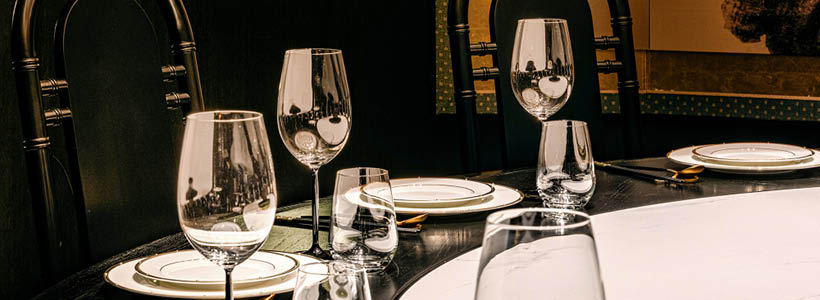
Rite is to man
what the green skin (Yun) is to a bamboo
or the solid core is to a pine (Song)
—The name of “Songyun Villa” is originated from “The Book of Rites”
First built in the 22nd year of ROC (1933) in Changzhou in east China’s Jiangsu Province, Songyun Villa is the most typical architecture of ROC period and is composed of a courtyard and a two-storied (three-storied in appearance) brick building. The name”Songyun Villa” were inscribed by Sha Yan. Formerly, there were a plaque bearing Chinese characters of “Grain Blessed Hall” inscribed by Tang Tuo, some couplets calligraphed by Zheng Xiaoxu and Zhuang Yunkuan and over a dozen of rare stone tablets in the villa. Now, there are decorative rocks from Taihu Lake in front of the Gate. The East Gate is featured by brick-carved gate tower, a half pavilion and drum-shaped stonepiers on both sides of the gate.
Unique Songyun
Situated in the bustling downtown of Changzhou, the hundred-year old Songyun Villa has now been opened to public after renovation. While remaining the original architectural style, an exquisite and deluxe restaurant has been built in the courtyard. The restaurant features the functional spaces for dining, high-end banquet, wine tasting, tea drinking and courtyard leisure, with 15 boxes of various sizes and one big dining hall.
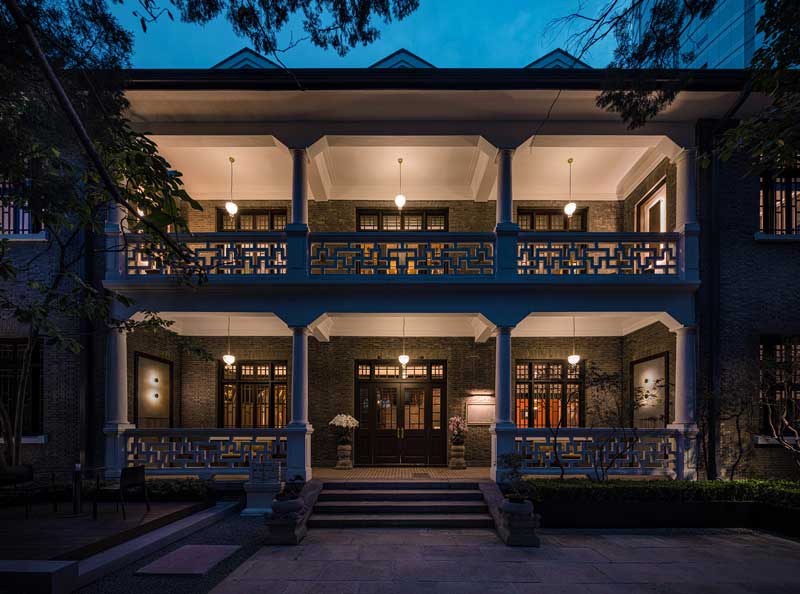
The designer, Bob Chen Design Office, combines traditional structure with modern spatial language.
With “tour in garden” as the main concept, the design ensures different views at each move and highlights diversified generatrix and spaces and the flexible arrangement of the dynamic and static space based on the actual conditions.
The Chinese and Western decorative elements are well integrated and gradually unveiled to let visitors enjoy a fantastic and intriguing journey and instill fresh vigor to the old architecture.
Spatial Layout Based on Actual Condition
The courtyard Songyun Villa maintains the white marble steles, screen wall, bluestone fish tank, various kinds of drum-shaped stone piers from the original site and other oriental elements of traditional courtyards. The renovation of the landscape and modern application scenarios in the new design enables theecho of natural elements inside and outside of the houses.
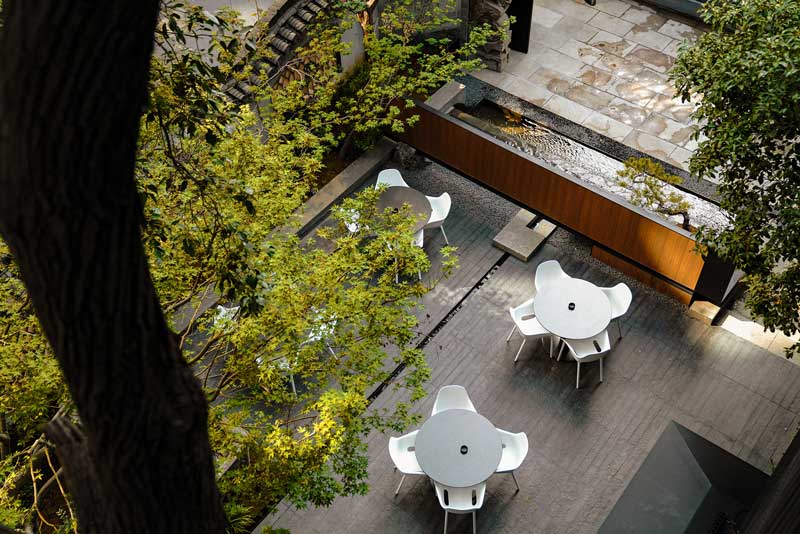
The courtyard, fresh and elegant with artistic taste, highlights harmonious coexistence with nature and is a place for sightseeing, recreation and pastime.
Idea First
The compact gallery and the expansive courtyard combine to form virtual-reality “gray space”with excellent lighting and form a striking contrast to the solid building. The space under the eaves at the entrance, decorated with screen, plaque, couplets, poems, calligraphy and paintings, evokeseffusive emotions and surreal poetic effect and shows humanistic care and the pursuit of poetic beauty.
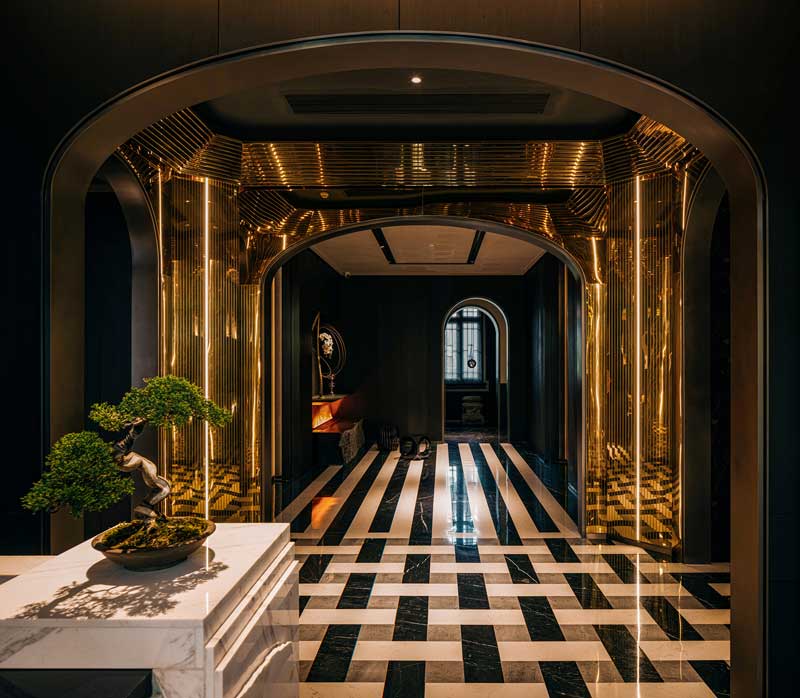
Conformity of Kind in Applying Colors
Intuitive, humanistic and subtle Chinese traditional culture collides with reasonable, straightforward and opening western culture. The architecture is a combination of Chinese and western style, with Chinese style being dominant and essential, and western style being supportive and decorative. The same is true to interior decoration. While following the elegant and stately traditional style characterized by strict symmetry in spatial layout, component structure and decorative motif and style, the architecture subtly introduces western art deco.
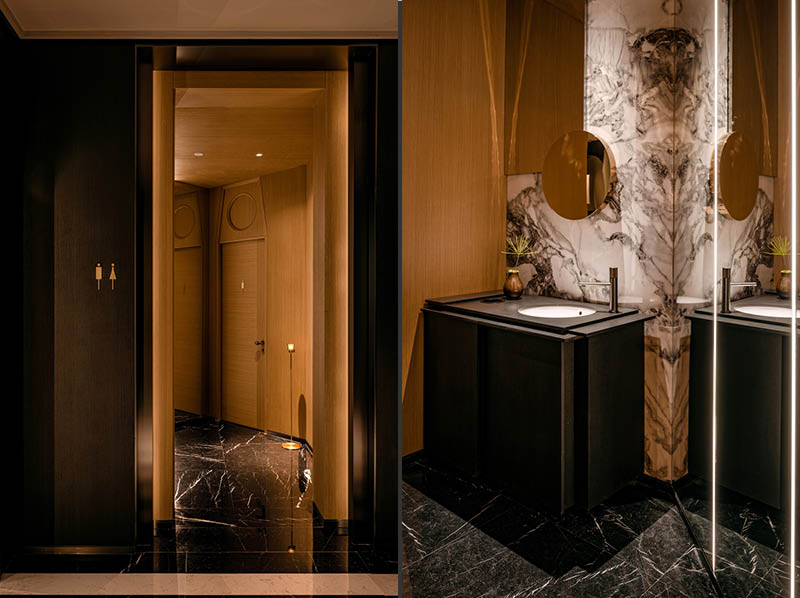
The geometric patterns and decorative elements, the alternated metal and stone materials, the contrast of saturated colors and gray scale combined to create a colorful and fantastic spatial environment.
Artistic Conception Beyond Objects
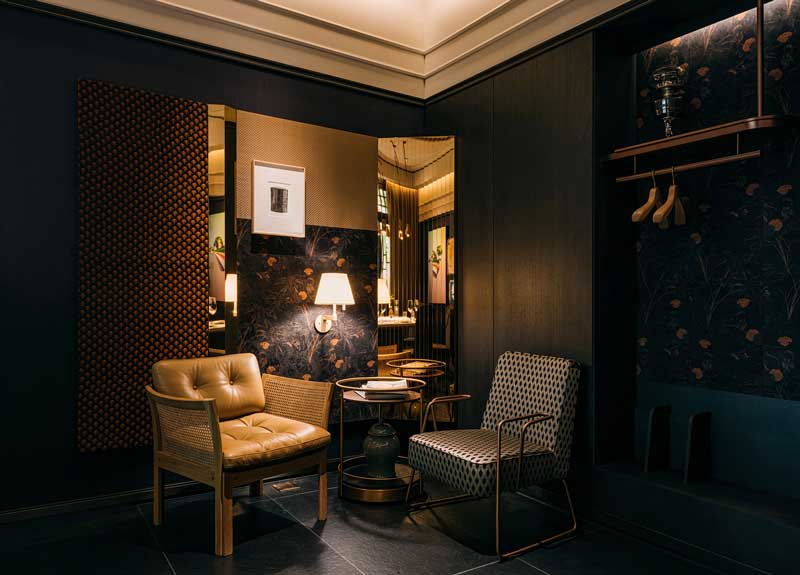
Through nuanced observation and contemplation of flowers, birds, landscapes and antique objects, the designer has grasped their essence and spirit and contrived an ideal living scene in his mind.
Through well-proportioned spacing, appropriate exposure and opening and other deco arts, the space of the restaurant has achieved the effect of layered views, indistinct boundary, changing space and decorative blending and is a poetic combination of setting and feeling, image and concept.
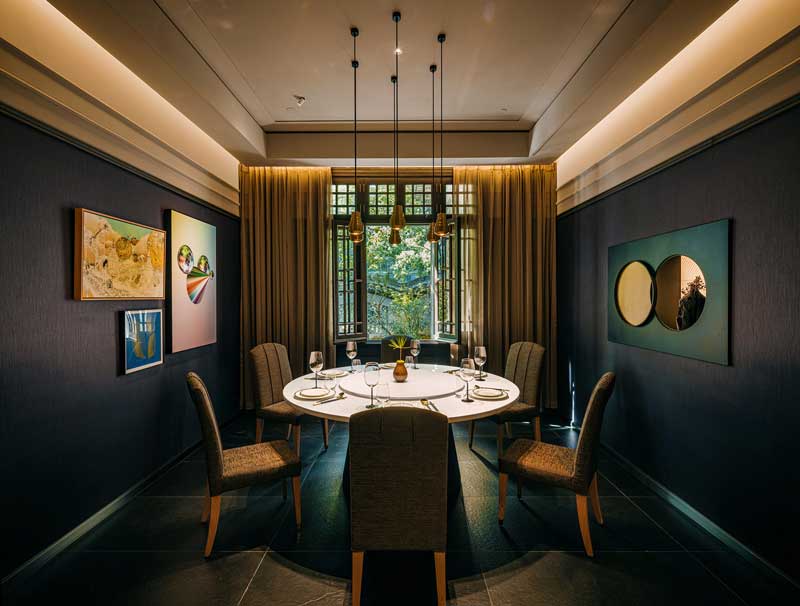
Pastimes
The cultural relics for refined pastime, including screen, calligraphy and painting, flower receptacle, incense burner, and tea sets, portray scenes of poetic life. The introduction of daily utensils and the consumption scenes bring worldly flavor to the artistic ambient for pastimes. Refined diversion is well integrated with daily recreation.
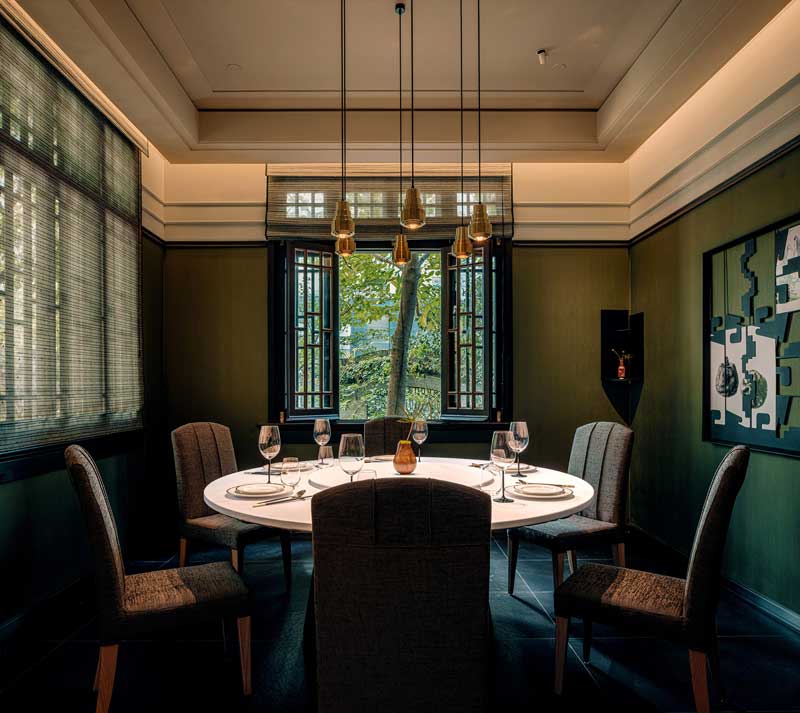
Refined Taste
The refined taste has been extended from four elegant and refreshing traditional plants, namely, plum blossom, orchid, bamboo and chrysanthemum, to natural seasonal vegetation. The roughly made bamboo-woven cage is used for containing blooming flowers.
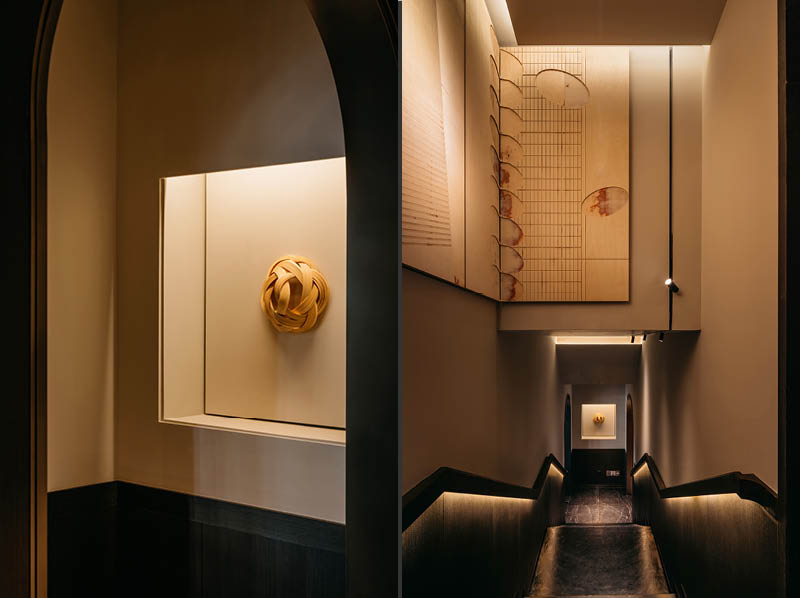
The texture on the plywood is like a natural movement in rhythm of curved and straight lines. In the eyes of the designer, even ordinary daily articles can be extraordinary.
Incessant Alternation of Seasons
Chinese culture has always attached equal importance to the combination and interplay of space and time, which has also been a philosophy in traditional spatial design. The visual expression of the interior space involves the perception and experience in the dimension of time. The concept of time is considered in the spacial treatment. The different styles in history are assembled and combined to represent the combination of space and time.
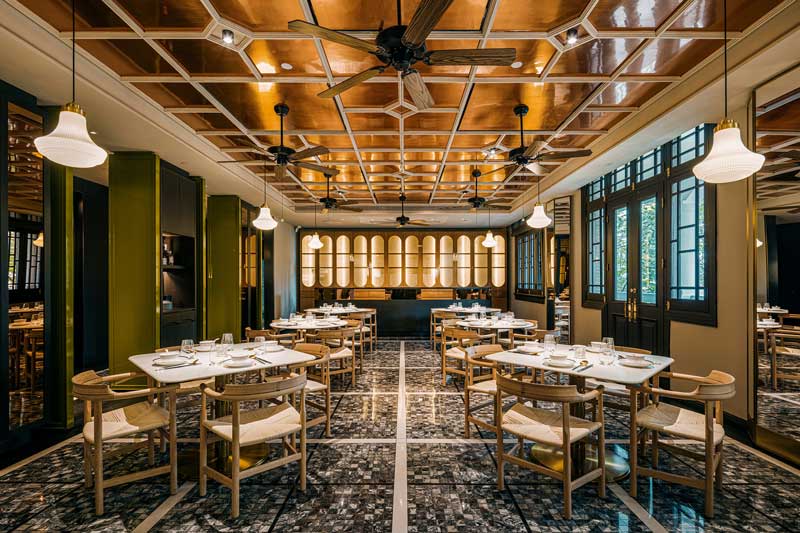
The boxes are private space with refined furnishings. The dinning area at the center is the focus of vision. The mixed-style decorative surface convenes a visual feast while you are enjoying a feast of foods. Also, the boxes provide specific sections for drinking tea or wine or chatting around the fire.
Layered spaces are created through appropriate layout. The sentimental decorative languages are meaningful and inclusive to create diversified multi-purpose spaces. The purpose of space can be changed by multiple combined functions of the decorative languages. The composite decorative forms, enclosed surface, layered space and functional attributes create a composite opening space, bringing diversified experiences to a certain space for the people.
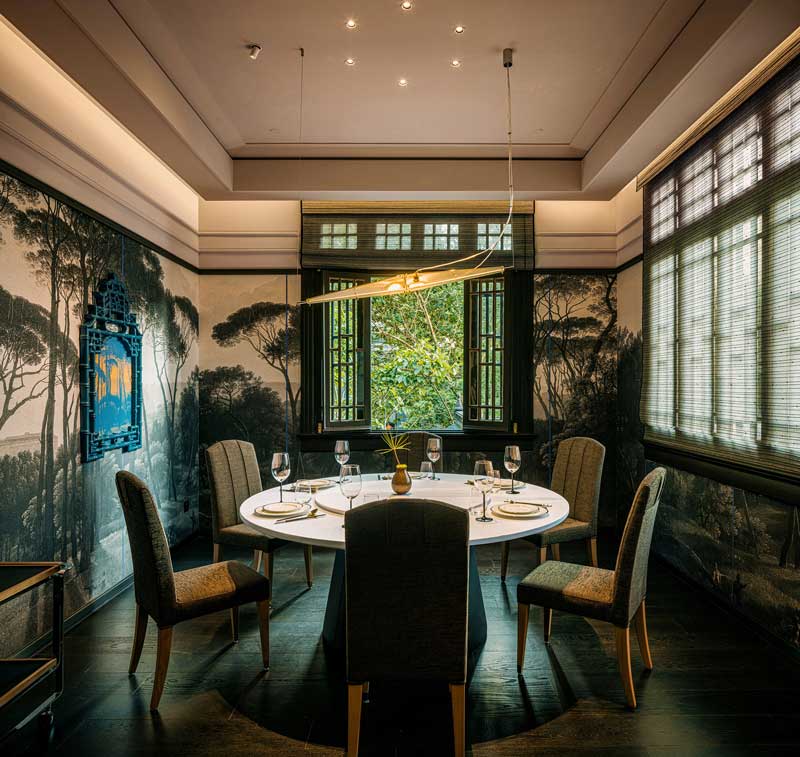
The building retains the basic design of the original staircase. One side of the rail has characteristic decorative patterns of the time, which strikes contrast to the extreme simple design on the other side. Setting off by inclusive black tone and the tarnishing-like surface treatment, the staircase is lustrous and time-honored, as if it is enveloped in vintage coating.
The retained skylight, like a shrine,serves as the frame of the natural scenery. The lights filtering through the skylights interplay with shadows to create a mysterious and solemn atmosphere. The lightingedges as the clock ticks, so that the space seems like the mapping of mind. The Art Deco style wall ornamentation and the wine cabinet offset the sharp lines and alternate simple lines with intricate designs. In this way, the small-sized space is big enough to demonstrate personality, natural beauty and culture.
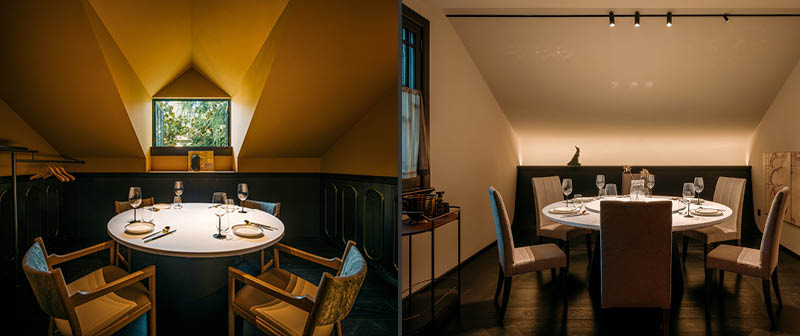
Different subdivided scenarios are provided for different pastimes. The space is a perfect example of virtualreality, coexistence of the tangible and intangible elements and combination of space and time. The rich imagination and superb experience brought by the interior decoration combined to present a poetic atmosphere that seems to exit only in dream and illusion.
Location Tianning District, Changzhou, China
Indoor Area 1000 sqm
Outdoor Area 1000 sqm
Design Bob Chen Design Office
Chief Designer Bob Chen
Photos courtesy Wen Studio
About BOB CHEN DESIGN OFFICE
Bob Chen Design Office was established in 2004 in Hangzhou. With more than 10 years of industry experience in fashion design publicity and brand investment operations, it provides a precise interpretation for brands establishment and publicity. With the advantage of resources integration, it provides customers with multi-approaches and mutually accessible design and implementation platform with commercial space design as the core, along with product design, visual communication.
Its team, led by the domestically well-known designer Bob Chen, is engaged in interdisciplinary design and research. After years of exploration in the field of design and art, it creates a new model of resources integration, which is dedicated to the establishment of platform for the Chinese traditional aesthetics and modern design communication.
About BOB CHEN
Bob Chen(born in 1979),is a designer, art director based in Hangzhou, China. Chen established BOBCHEN Design Office in 2004. In 2010, he launched the furniture brand “Touch Feeling”. His works span through visual communication, products and space design. Over the years, he continually focuses on the design of consumer experience scenes, and has accumulated rich experiences in the fields of hotel design and residence design.
In 2005, Chen won the Gold Award, Bronze Award and Merit Award in the “Graphic Design in China 2005”. In 2006, he was selected by “the 5th edition of Meggs ‘History of Graphic Design” in Germany. In the same year, his work was collected by the V&A museum in Britain. He was selected by American Print magazine as one of” the 20 new visual artists under the age of 30″ in 2007. In 2009, Chen was selected by Tokyo TDC award , nominated for the non-member gold award and won the Merit Award. In 2012, he participated in “Sit Down” Milan China Contemporary Design Exhibition. In 2015, he participated in the 3rd Milan China Contemporary Design Exhibition. In the same year, he was selected as one of the top 30 most promising designers in the Chinese version of Forbes. In 2016, he was both shortlisted for the 3rd China Design Person of the Year and the National New Trend of Chinese Interior Design. From 2013 to 2021, Chen has been selected five times as one of the 100 most influential architectural design elites in China by “AD magazine”.


